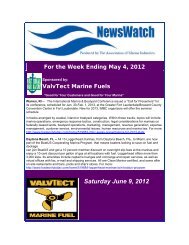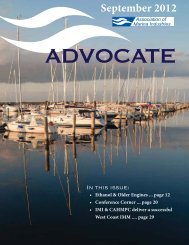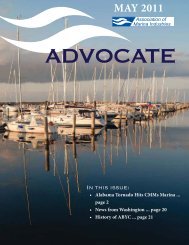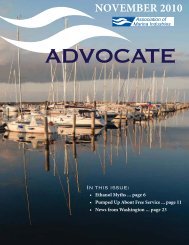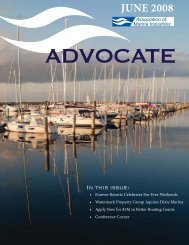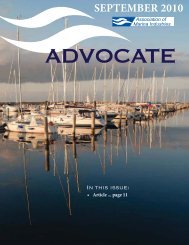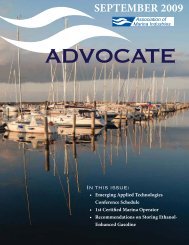Download a copy of AMI's Clean Marina best management practices ...
Download a copy of AMI's Clean Marina best management practices ...
Download a copy of AMI's Clean Marina best management practices ...
You also want an ePaper? Increase the reach of your titles
YUMPU automatically turns print PDFs into web optimized ePapers that Google loves.
• Distribute Literature to Customers<br />
- Send tip sheets with monthly mailings.<br />
- Include BMP articles in newsletters.<br />
- Contact the U.S. Coast Guard for publications on federal boating requirements.<br />
- Erect and maintain a marina bulletin board.<br />
- Post your facility’s environmental policy in a conspicuous location.<br />
• If customers/contractors do not follow their contracts you can take the following steps:<br />
- Talk to the boater or contractor again.<br />
- Mail a written notice asking that the harmful practice stop. Keep a record <strong>of</strong> the mailing.<br />
- Remove the problem from the dock. Charge the boater or contractor for the cost <strong>of</strong> removal and<br />
clean-up.<br />
- Ask the tenant or contractor to leave your marina.<br />
Business Practices<br />
• Scrape, sand, and paint in-water and landside structures according to the same <strong>management</strong> principles as<br />
for vessels.<br />
• Sell environmental products, especially if you require them for BMPs<br />
• Offer Environmental Audits for Boaters<br />
• Inspect engines, bilges, fuel systems, and marine sanitation devices (the most common cause <strong>of</strong> water<br />
pollution from boats).<br />
• Avoid environmental surcharges by charging for tangible items such as tarps, vacuum sanders, and<br />
protective clothing.<br />
Emergency Planning<br />
Maintain Material Safety Data Sheets<br />
• Keep a file <strong>of</strong> Material Safety Data Sheets (MSDS) for all products used at your facility, as required by<br />
the Occupational Safety and Health Act <strong>of</strong> 1970 (29 USC Sec. 657). MSDS can be found online at<br />
http:// www.msdssearch.com/msdssearch.htm. Store the file in an <strong>of</strong>fice away from material storage<br />
areas.<br />
• Inform the local Emergency Planning <strong>of</strong>fice what materials you store and what is released when they<br />
burn.<br />
Assess Coastal Hazards<br />
• Designate a conscientious response person for any emergencies involving hazardous materials.<br />
• Consider and plan for these likely threats:<br />
- Chemical or oil spill<br />
- Holding or water tank filled with gas<br />
- Fire<br />
- Health emergency<br />
- Hurricane/Nor’easter<br />
- Tornado<br />
- Flood<br />
Develop Emergency Response Plans<br />
• Develop written procedures describing actions to be taken under given circumstances. The plans should<br />
be clear, concise, and easy to use during an emergency. Include information about what type <strong>of</strong><br />
equipment is available on site and what its characteristics and capabilities are.<br />
• Keep copies <strong>of</strong> all Emergency Response Plans in a readily accessible location.<br />
4



